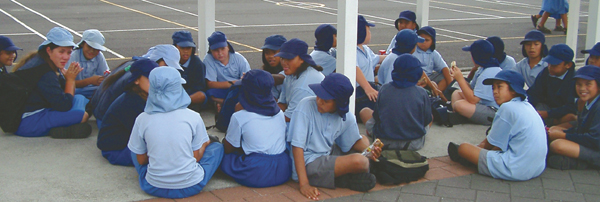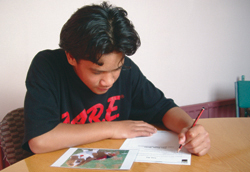|
Sampling
general education schools
At year 8 level, 120 schools were selected randomly from national
lists of state, integrated and private schools teaching at that level,
with their probability of selection proportional to the number of
students enrolled in the level. The process used ensured that each
region was fairly represented. Schools with fewer than four students
enrolled at the given level were excluded from these main samples,
as were special schools and Mäori immersion schools (such as
Kura Kaupapa Mäori).
Sampling Mäori immersion schools
Ten schools were selected randomly from Mäori immersion schools
(such as Kura Kaupapa Mäori) that had at least 4 year
8 students, and from other schools that had at least 4 year 8 students
in classes classified as Level 1 immersion (80 to 100 percent of instruction
taking place in Mäori). Seven of the chosen schools were immersion
schools and three were general education schools with immersion classes.
These proportions reflected our estimate of the relative numbers of
students nationally in the two types of programme who met our requirement
of more than four years of Mäori immersion education.

Pairing small schools
Five of the 120 chosen schools in the general education sample had
less than 12 year 8 students. For each of these schools, we identified
the nearest small school meeting our criteria to be paired with the
first school. Wherever possible, schools with 8 to 11 students were
paired with schools with 4 to 7 students, and vice versa. However,
the travelling distances between the schools were also taken into
account. Four of the 10 schools in the Mäori immersion sample
also needed to be paired with other schools of the same type.
Contacting schools
In telephone calls with the principals, we briefly explained the purpose
of national monitoring, the safeguards for schools and students, and
the practical demands that participation would make on schools and
students. We informed the principals about the materials which would
be arriving in the school (a copy of a 20 minute NEMP videotape plus
copies for all staff and trustees of the general NEMP brochure and
the information booklet for sample schools). We asked the principals
to consult with their staff and Board of Trustees and confirm their
participation. Similar procedures were followed with the principals
of the 14 schools in the Mäori immersion sample, but for them
brochures in both Mäori and English were sent.
Three of the originally sampled 120 schools in the general education
sample withdrew because of complications at their schools, and were
replaced by other schools in their district with similar characteristics.
In the Mäori immersion sample, one immersion school declined
to participate and was replaced by another immersion school from the
same region. One of the sampled schools with immersion classes initially
agreed to participate but later withdrew after consultation with its
whanau, and was replaced by another school with immersion classes
from the same region.
Sampling of students
With their confirmation of participation, each school sent a list
of the names of all year 8 students on their roll. Schools in the
Mäori immersion sample were asked to list only the names of students
who were in at least their fifth year of Mäori immersion education.
Using computer generated random numbers, we randomly selected the
required number of students (12, or 4 plus 8 in a pair of small schools),
at the same time clustering them into random groups of four students
(which would be allocated different sets of assessment tasks).
The schools were then sent lists of their selected students and invited
to inform us if special care would be needed in assessing any of those
students (e.g. students with disabilities or new immigrants to New
Zealand with very limited skills in English). Where necessary, replacement
students were chosen, using the same random sampling procedures. Less
than 2 percent of students were replaced for reasons other than moving
school or planned absence for the full assessment week.
Communication with parents
Following these discussions with the school, Project staff prepared
letters to all of the parents, including a copy of the NEMP brochure,
and asked the schools to address the letters and mail them. Parents
were told they could obtain further information from Project staff
(using an 0800 number) or their school principal, and advised that
they had the right to ask that their child be excluded from the assessment.
Less than half a percent of the selected students were replaced because
they or their parents declined to participate.
Practical arrangement with schools
On the basis of preferences expressed by the schools, we then allocated
each school to one of the five assessment weeks available and gave
them contact information for the two teachers who would come to the
school for a week to conduct the assessments. We also provided information
about the assessment schedule and the space and furniture requirements,
offering to pay for hire of a nearby facility if the school was too
crowded to accommodate the assessment programme.
Resulting samples
For the purposes of this report, we were interested in four groups
of year 8 students:
-
Mäori students in the one third of the general education
sample who attempted task set A
(a total of 95 students);
-
Mäori students in the one third of the general education
sample who attempted task set B
(a total of 90 students);
-
Mäori students in the half of the Mäori immersion sample
who attempted task set A
(a total of 42 students);
-
Mäori students in the half of the Mäori immersion sample
who attempted task set B
(a total of 47 students).
The
two Mäori immersion groups were 20 to 30 percent smaller than intended.
At several schools, the numbers of students available with more than
four years of immersion education were lower than originally anticipated.
It was impractical to approach further schools by the time this became
apparent. As a result, one school had one group of four students and
one group of three students rather than three groups of four students,
two schools had one group of five students rather then two groups of
four students, and four groups at other schools contained three rather
than four students. This loss of 14 students was increased when 17 of
the students either left school after being selected but before the
assessments or were absent for all assessments.
For tasks in set A, the performance of students in the first and third
groups are compared. For tasks in set B, the performance of students
in the second and fourth groups are compared.
|

